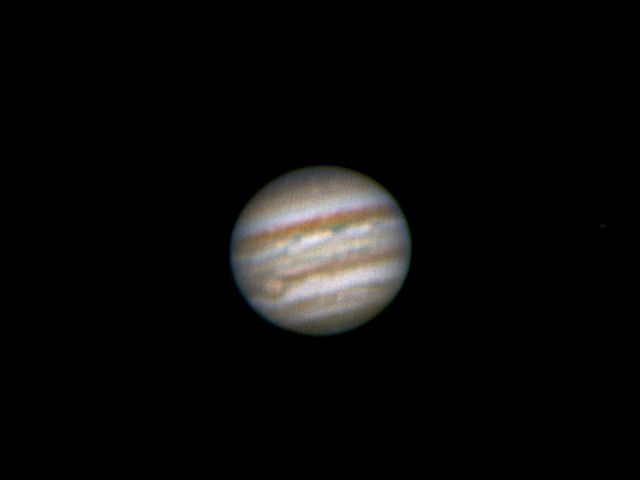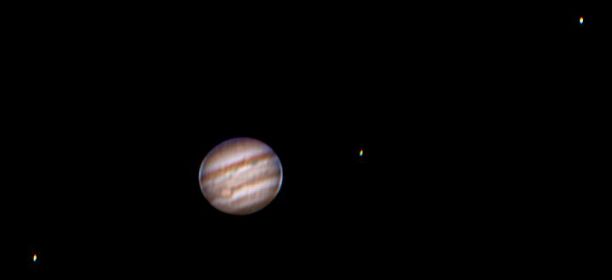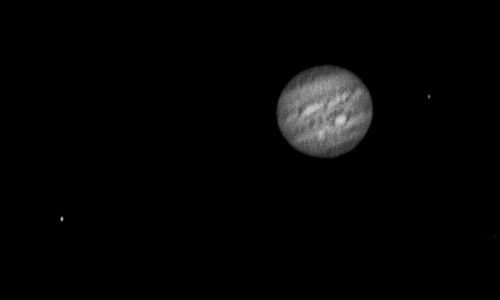 |
This was the first picture I took that night, at 22:11 UT. That is 1 hour and 46 minutes before the picture that brought you here, but see how much further west the GRS is. Pictures below show how it moved over that time.
Date and Time: 11 May 2006 22:11 UT
Camera: ToUcam 740K
Telescope: LX200 with X2 lens
Capture: K3CCDTools. Low gamma, 1/25", 35% gain, 451 frames
Processing: Registax. 129 frames stacked. Wavelet 1-3 = 10, contrast 130, brightness -10 |
|
 |
This picture, taken about 15 minutes after the one above, is one of the best I have ever obtained of Jupiter and three of the major satellites in a single exposure. (Move your mouse over the image to see which is which.) Callisto was too far from the planet to get both it and Jupiter on the CCD at the same time. In fact this picture is a mosaic of two pictures, one capturing Io, Jupiter, and Europa, and the other capturing Jupiter, Europa and Ganymede, which were stitched together in iMerge using Jupiter as the reference object. I have had to shrink the picture to 85% in order to fit it on this page.
Date and Time: 11 May 2006 22:29 and 22:32 UT
Camera: ToUcam 740K
Telescope: LX200 at prime focus
Capture: K3CCDTools. High gamma, 1/33", 17% gain, 450 frames
Processing: Registax. 132 and 107 frames stacked. Wavelet 1-2 = 10, gamma 0.6, histogram 70-230 |
|
 |
These four pictures were taken at intervals over the course of nearly two hours. The actual times (UT) are shown below the images. Jupiter revolves very rapidly and this sequence shows the GRS moving west to east across the face of the planet as it rotates. The first and last images were captured with the X2 lens attached but have been shrunk by 50% to be comparable with the other two images captured at prime focus. The original of the first image is above and of the last image is on the previous page.
Date and Time: 11th May 2006 between 22:11 and 23:57 UT
Camera: ToUcam 740K
Telescope: LX200 at prime focus
Capture: K3CCDTools. Low gamma
Processing: Registax. |
|
 |
Finally this picture was taken in the infra-red. Notice how well the GRS and Go's Spot (aka Red Spot Jr.) show up, along with a number of features in the belts. The two satellites, Io and Europa, also stand out in the IR; all four of the Galilean satellites reflect infra-red light more strongly than Jupiter does. Their icy surfaces, compared to the gaseous surface of Jupiter, probaly account for this.
Date and Time: 11 May 2006 23:38 UT
Camera: ToUcam 740K
Telescope: LX200 at prime focus with IR-pass filter
Capture: K3CCDTools. Low gamma, 1/25", 52% gain, 451 frames
Processing: Registax. 114 frames stacked. Wavelet 1-3 = 10, contrast 115, brightness 15 |

